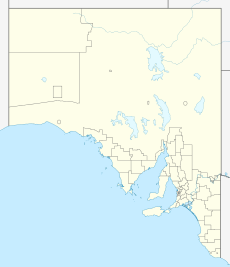Wolseley Common Conservation Park facts for kids
Quick facts for kids Wolseley Common Conservation ParkSouth Australia |
|
|---|---|
|
IUCN Category III (Natural Monument)
|
|
| Nearest town or city | Wolseley |
| Established | 29 November 2001 |
| Area | 24 hectares (59 acres) |
| Visitation | “receives few visitors” (in 2006) |
| Managing authorities | Department for Environment and Water |
| See also | Protected areas of South Australia |
Wolseley Common Conservation Park is a special protected area in South Australia. It is located near the town of Wolseley. This park is about 260 kilometers (160 miles) south-east of Adelaide, the state capital. It is also about 13 kilometers (8 miles) south-east of Bordertown.
The park was created to protect important plants and animals. It covers an area of about 24 hectares (59 acres). This makes it a safe home for many native species.
Contents
Why Was Wolseley Park Created?
Wolseley Common Conservation Park was officially opened on November 29, 2001. It was set up under the National Parks and Wildlife Act 1972. The main goal was to protect a special type of forest called "Buloke Woodland." This woodland is very rare in South Australia.
Protecting Rare Plants and Animals
The park also protects other important plants and animals. These species are considered to be of "conservation significance." This means they are important for the health of the environment. They might be rare or threatened.
History of the Park Land
The land that is now Wolseley Common Conservation Park has an interesting past. It was once part of the parklands around the town of Wolseley. These parklands were first set aside in 1884.
How the Land Was Used Before
For many years, people used these parklands in different ways. They would let their animals graze there. People also gathered firewood and sometimes even dumped rubbish. During World War 2, part of the land was cleared. It was turned into a sports oval with a track for cycling and running.
Nature's Comeback
By the 1960s, much of the land was bare. Only a few Buloke trees remained. However, as Wolseley became less busy as a railway town, the land started to heal. The native plants began to grow back naturally. This allowed the area to become the important conservation park it is today.
What Makes Wolseley Park Special?
In 2006, experts described the park's unique features. It has a very special forest called "Buloke Low Woodland." This forest is known for its healthy understorey. The understorey is the layer of plants that grows beneath the main trees.
Amazing Plant Life
The park's understorey has many different native grasses, sedges, and other plants. It is considered one of the best examples of a pure Buloke Low Woodland. This type of forest grows on a special kind of soil called gilgai soil. The park is home to at least 68 native plant species. Eleven of these are listed as threatened under the National Parks and Wildlife Act 1972.
Diverse Bird Species
Wolseley Common Conservation Park is also a haven for birds. At least 30 different bird species have been seen there. Seven of these birds are considered important for conservation in the South East region. These include:
- yellow thornbill (Acanthiza nana modesta)
- white-winged chough (Corcorax melanorhamphos whitaea)
- red-capped robin (Petroica goodenovii)
- collared sparrowhawk (Accipiter cirrhocephalus)
- sulphur-crested cockatoo (Cacatua galerita)
- long-billed corella (Cacatua tenuirostris)
Reptiles and Mammals
The park is also home to six types of reptiles. One important reptile is the Olive Snake-lizard (Delma inornata). This lizard is rare in South Australia. So far, the only native mammal recorded in the park is the Fat-tailed dunnart (Sminthopsis crassicaudata).
Park Access and Importance
As of 2006, the park received few visitors. It was mostly used by local residents for casual visits.
The Wolseley Common Conservation Park is recognized internationally. It is classified as an IUCN Category III protected area. This means it is important for protecting natural features.


